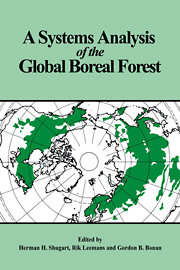Book contents
- Frontmatter
- Contents
- List of contributors
- 1 Introduction
- Part 1 Processes in boreal forests
- Introduction
- 2 Silvics of the circumpolar boreal forest tree species
- 3 The reproductive process in boreal forest trees
- 4 Soil temperature as an ecological factor in boreal forests
- 5 Fire as a controlling process in the North American boreal forest
- 6 The role of forest insects in structuring the boreal landscape
- Part 2 Patterns in space and time in boreal forests
- Part 3 Computer models for synthesis of pattern and process in the boreal forest
- References
- Index
3 - The reproductive process in boreal forest trees
Published online by Cambridge University Press: 12 January 2010
- Frontmatter
- Contents
- List of contributors
- 1 Introduction
- Part 1 Processes in boreal forests
- Introduction
- 2 Silvics of the circumpolar boreal forest tree species
- 3 The reproductive process in boreal forest trees
- 4 Soil temperature as an ecological factor in boreal forests
- 5 Fire as a controlling process in the North American boreal forest
- 6 The role of forest insects in structuring the boreal landscape
- Part 2 Patterns in space and time in boreal forests
- Part 3 Computer models for synthesis of pattern and process in the boreal forest
- References
- Index
Summary
Introduction
The reproductive process plays an important role in determining species composition and distribution. At the landscape level, the variation in density and species composition of forests growing on similar, but geographically separated, sites is related to the quantity and type of reproductive material, the nature and severity of disturbance, and the growth requirements of the species comprising the forest. Within a given site, the spatial and age distribution of trees and associated plant species is, in part, a consequence of the nature of the substrate following disturbance and the ability of residual or new reproductive material to survive and develop under the prevailing biotic and abiotic conditions.
Regeneration of boreal forests varies in time and space. Temporal variation takes into account such variables as the periodic nature of seed production and changing seedbed conditions. Spatial variation includes factors such as seed dispersal distance and pattern of surface conditions as related to dynamics of sexual and asexual reproduction.
The state and dynamics of regeneration vary with the condition of the forest ecosystem. Natural disturbances, for example fire and major wind damage, remove or destroy variable amounts of the above-ground system, including the forest floor, and below-ground reproductive material, creating a continuum of conditions that determine the relative importance of sexual reproduction and vegetative regeneration to secondary succession. Colonization and forest development on newly formed or exposed sites (e.g. primary succession along rivers or following glacial retreat) is usually dominated by sexual reproduction, owing to the absence of pre-existing vegetation.
- Type
- Chapter
- Information
- A Systems Analysis of the Global Boreal Forest , pp. 85 - 125Publisher: Cambridge University PressPrint publication year: 1992
- 60
- Cited by



